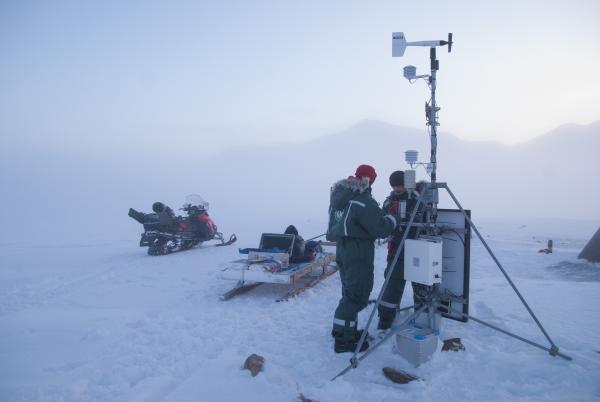A number of scientific use cases are described for the development of the CVL system. These are further described below (in progress).
-
Operational validation of sea ice forecasts near Svalbard
The CVL provides access to various satellite and in situ observations of the cryosphere in one place. This makes it a unique platform for data intercomparison and, in particular, for calibration/validation activities. In this Use Case, it is planned to collect high resolution and high frequency satellite and in situ observations of essential sea ice parameters in waters around Svalbard. These observations are compared with results from neXtSIM sea ice model simulations (see description below). Special emphasis will be given to meso- and submesoscale processes reproduced by the model: wave induced ice breakup, advection of sea ice trapped by eddies into warmer ocean, heat fluxes in sea ice leads. This comparison allows evaluation of accuracy and usability of the short term neXtSIM forecasts, both for practical purposes (mitigating threats for navigation and oil/gas operations) and for understanding of physical processes. In addition, it allows calibration of the parameters for both the model and the
algorithms for processing remote sensing data. -
Early detection of phytoplankton blooms near ice edge
In this use case it is planned to utilize CVL for visualization and intercomparison of data on phytoplankton bloom near ice edge as detected by satellite borne lidars and predicted by an ecological model. The model results will be validated and disseminated to interested industrial stakeholders (e.g., scientific cruises or fisheries).
-
Arctic Amplifications on and around Svalbard
 Over the past three to four decades, the Arctic’s temperature has risen about twice the global average (AMAP 2017). The Svalbard and Barents region is experiencing the fastest temperature increases within the circumpolar Arctic (Isaksen et al. 2016), along with the highest rate of sea ice loss (AMAP 2017). In the Arctic Ocean the sea ice loss has been largest during summer (e.g. Comiso, 2012). In contrast, the sea ice cover in Svalbard region and Barents Sea has experienced a larger decline during winter. Compared to the other seasons, the most dramatic ice loss near Svalbard has occurred in winter. The location of Svalbard, presently at the border between a temperate Atlantic and a cold Arctic climate, makes it a hotspot for study the mechanisms of Arctic amplification, and how climate changes may influence the interactions between ocean,
Over the past three to four decades, the Arctic’s temperature has risen about twice the global average (AMAP 2017). The Svalbard and Barents region is experiencing the fastest temperature increases within the circumpolar Arctic (Isaksen et al. 2016), along with the highest rate of sea ice loss (AMAP 2017). In the Arctic Ocean the sea ice loss has been largest during summer (e.g. Comiso, 2012). In contrast, the sea ice cover in Svalbard region and Barents Sea has experienced a larger decline during winter. Compared to the other seasons, the most dramatic ice loss near Svalbard has occurred in winter. The location of Svalbard, presently at the border between a temperate Atlantic and a cold Arctic climate, makes it a hotspot for study the mechanisms of Arctic amplification, and how climate changes may influence the interactions between ocean,
atmosphere and cryosphere.
A number of feedback mechanisms, some of them unique to the Arctic, are responsible for the more rapid warming observed over the Arctic compared with the rest of the world. These feedbacks amplify warming well beyond the effects caused by increasing greenhouse gas concentrations alone (AMAP 2017). The most known comes from changes in surface reflectivity due to the melting of snow and ice. As reflective surfaces are replaced by darker surfaces such as open water or land, less energy is radiated back to space and the region warms further, leading to still more melting.
The Svalbard region experience more open water beyond the expected autumn period. This cause strong feedbacks that to a large extent slow the formation of ice in autumn causing an increase in open water fraction even in winter. The open-water fraction plays a significant but as yet poorly defined role in the observed increase in exchange of heat and moisture within the atmospheric boundary layer. In addition, more broken sea-ice cover (with leads and polynyas) further affects the thermodynamics of the atmospheric boundary layer and the cumulative effect on boundary-layer temperatures is large when an air mass travels a long distance over a broken sea-ice cover (AMAP 2017). Studies have shoved (e.g. Tetzlaff et al. (2013)) that a major part of the variance of 2-m temperature of air masses arriving land areas around Arctic Ocean is explained by the surface temperature distribution along the air mass trajectory.
Studies in Canada have shown that cyclones have a strong impact on heat exchange across the ocean-ice atmosphere interface into the boundary layer (Raddatz et al.,2014) and that once this ocean heat has entered the boundary layer it can be advected over large distances affecting regional heat and moisture fluxes (Raddatz et al., 2012). The impacts of a more mobile ice cover thus play an important role in both how the atmospheric boundary layer evolves as well as how it scales up to affect regional processes from what are very locally generated points of flux (AMAP 2017). -
Snow, sea ice and phenological cycles in Svalbard
The average temperatures on Svalbard have risen significantly over the last 20 years. This should have a significant impact on snow and ecology. Also the length of the sea-ice season plays a role. In this use case we want to quantify the interdependencies between the various cryosphere and phenology cycles by using as much EO and in situ data as possible.
-
Avalanche activity on Svalbard
The intimate relation between avalanche activity detected by satellites and the weather history for the region has been documented in Eckerstorfer (2017) for Tromsø. We want to study the same phenomenon in Svalbard over several seasons. In addition to weather parameters such as temperature, wind and precipitation we also want to quantify how wet snow as observed from satellite can be used to predict avalanche activity.





